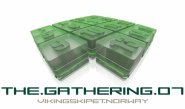The Gathering 2007
Håkon Wium Lie, chief technology officer at Opera software was here today to tell us about the one laptop per child project, also known as OLPC.
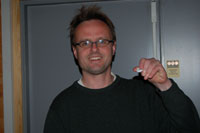
The auditorium was filled with curious geeks who had come to check out this device that looked like it came from Fisher Price rather than being a project supported by many of the IT giants, such as google and AMD to name a few.
The OLPC was founded by Nicholas Negroponte who also founded the MIT media lab. He wanted every child in the world to get the opportunity to have a computer and thus have the same possibilities as kids in the industrial world have. OLPC is now a foundation where Nicholas is chairman and they see this as a mission rather than business.
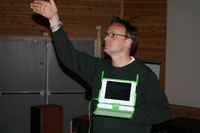
Håkon speaks to the masses
The project is as much about education as it's about computing because although one might ask oneself wether it's a good idea to give kids laptops when there are so many that can't even afford food, it connects people, and besides, why shouldn't the people in the poor countries have access to the same information that we do?
The laptop itself uses an 366 MHz AMD x86 processor and it 128 MB RAM (though, some models have 256) and a 512 flash memory. It does not have any hard drives - actually, there are very few moving parts on it at all, but more about that later. Red hat is making the Linux-based operating system for it, but in theory you should be able to install any distro that you want on it. It is also equipped with wifi and USB ports so that children can use electronic school books. It is also able to surf the web and do e-mails. The laptop is also equipped with a web-cam, and after Håkon demonstrated it to us, it turned out to be of decent quality as well.
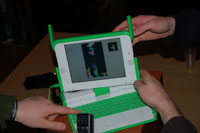
The machine in all its glory
It looks like a Fisher Price toy, and this was done on purpose as these are laptops aimed for school children, not adults. If it had a generic look, there could be problems with people stealing or otherwise taking the laptops from kids and selling them as it is worth a lot of money in some of the countries it's being sold to. The keyboard is also smaller than it would be on most laptops which is also a good indication that it indeed is for kids. The screen is based on a new LCD design that allows for greater power saving and thus lower power consumption. It also has a mode without backlights where in works as a sun-reflexive screen which will come in handy as most of the buyer countries will be countries with many sunny days. It also does not come pre-packed with applications as openoffice etc. This is again because it is aimed at education, not office and other "grown up" stuff.
The target price of the laptop is $100 USD, although the price may be slightly higher initially.
Here are some interesting questions that got asked:
Will the laptop get launched in the industrial countries? Håkon would like for the machines to be available for kids in the industrialized world, as well as the developing world. Some kids in rich countries have laptops, but it's not universal. By giving a $100 laptop to everyone, the machine could become an equalizer.
The OLPC project only sells machines in batches to governments to be able to keep the costs as low as possible. For now, developing countries are given priority. Wether the machine will be available to industrial countries may also be a supply question -- there isn't enough production lines to give every child in the world a machine tomorrow.
One proposed idea is to sell the machine at a higher price in rich countries, maybe $200 or $300 USD. That way the computers will still be cheaper than regular laptops, but the profit can be used to finance computers in developing countries.. That way the computers will still be cheaper than regular laptops, but the profit can be used to finance computers in developing countries.
It should be noted that the manufacturer of these computers are working on their own low-budget laptop. What the price will be, if it will be a part of the OLPC project and where it will be sold is not yet certain.
The laptop is developed mainly for kids to use. Will it be sturdy so that it won't break easily? There are very few moving parts in the laptop, e.g it does not have a hard drive that spins. We have calculated that it will last for about five years which is more than the life expectancy of the laptops we use here, so it is designed with that in mind. Of course, we know that not all PC's will hold up that long, but there are faulty laptops in any price and quality range.
Also, we think that there will show up repair shops for the laptops just like there are bike repair shops etc in developing countries today. Therefore, it will be able to fix the laptop locally and thus contribute more to the society as a whole.
Can you play wow on it? Somebody has already played doom on it and tetrinet might work as well.
Will it be available in a different color scheme? It has been suggested that one could price the machine a different levels depeding on its color to price the different color schemes differently in the industrialized world, such as green $300, pink $500 etc to raise even more money for the project.
Does the project have a web page? yes, www.laptop.org
What kind of developer tools will be available? The people behind this project wanted kids to be able to learn how to program, so the programing environments available are python, javascript, Csound, Squeak and Logo.
What is opera's involvement in all of this? Opera is making a browser for this laptop. However, it will not come shipped with the computer because opera is propertairy software.
...and what about security? No services are running per default, so there's nothing to attack besides the kernel. However, the project has got some excellent security people to take care of security and they have given it lots of thoughts, so it will be reasonably well.
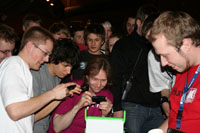
Geeks checking out the laptop.
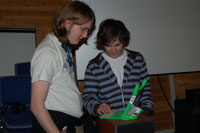
It plays music!
We just have to thank Håkon Wium Lie for coming here and show us this interesting little machine, and we wish the OLPC project the best of luck.
Thanks to Toresbe, Gather and leikarnes for the pics.
Design by: PAL/Offence/A (Flott altsaa)
The Gathering is a registered trademark by KANDU
